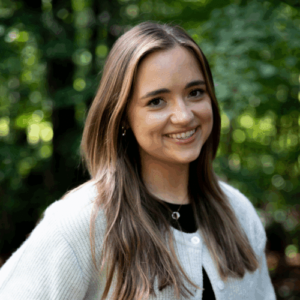When most people think about eating disorders, they picture anorexia or bulimia — the ones we hear about most often in movies, on social media, or at school. But there’s a whole spectrum of lesser-known eating disorders that can be just as harmful, yet often go unnoticed or misunderstood.
For individuals struggling with disordered eating behaviors, it can be life-changing to learn that other eating disorders exist. It can put a name to what they’ve been experiencing, help them realize they’re not alone, and open the door to treatment they didn’t know applied to them. Without that awareness, too many people slip through the cracks, believing their struggles aren’t “serious enough” to matter — when in reality, they do.
Lesser-Known Eating Disorders + Their Symptoms
1. ARFID (Avoidant/Restrictive Food Intake Disorder)
ARFID goes far beyond “being a picky eater.” Individuals with this disorder may avoid foods because of extreme texture, taste, or smell sensitivities, fear of choking or vomiting, or simply a lack of interest in eating — and it’s not about body image at all.
While some assume ARFID is just being “fussy” about food, in reality, it’s a serious mental health condition that can lead to malnutrition, weight loss, and intense social avoidance. It’s especially common in individuals with autism, sensory sensitivities, or anxiety, but because weight often stays in a “normal” range, it may be overlooked until serious health problems appear (Bryant-Waugh et al., Appetite, 2019).
2. Night Eating Syndrome (NES) + Sleep‑Related Eating Disorder (SRED)
Night eating syndrome (NES) is more than just the occasional midnight snack. It’s a recognized eating disorder (classified in the DSM‑5 under Other Specified Feeding or Eating Disorders, or OSFED) where an individual regularly consumes a significant portion of their daily calories after dinner or wakes up during the night to eat — and they’re fully aware of it and can remember it the next day.
Sleep-related eating disorder (SRED), on the other hand, is a sleep disorder where an individual eats — sometimes strange combinations or even non‑food items — with little to no memory of it the next day. This behavior is considered a type of parasomnia and is sometimes associated with other eating disorders or sleep disorders, such as insomnia or narcolepsy. It can cause injuries, burns, or rapid weight gain. Because NES can look like “late‑night snacking” and SRED can be mistaken for sleepwalking, both can go undiagnosed for years (Howell et al., Sleep Medicine Clinics, 2018). Treatment for SRED often involves addressing both the eating behaviors and any underlying sleep issues.
3. Pica + Rumination Disorder
Pica is an eating disorder that goes far beyond the occasional childhood curiosity of tasting something that isn’t food. In the DSM‑5, it’s defined as the persistent craving and consumption of non‑nutritive, non‑food substances — things like dirt, clay, chalk, paper, hair, or even ice — for at least one month, and in a way that isn’t culturally or developmentally typical. Pica is often seen in children, pregnant women, and individuals with developmental or intellectual disabilities, but it can occur in anyone. The exact causes of pica are not fully understood, but it may be related to nutritional deficiencies, stress, obsessive-compulsive tendencies, or underlying mental health conditions. Left untreated, pica can cause serious medical problems, from intestinal blockages to lead poisoning, depending on what’s ingested (Kumar et al., Journal of Clinical and Diagnostic Research, 2012).
Rumination disorder is more common than most people think, especially in certain age groups. According to the DSM‑5, it involves the repeated regurgitation of food after eating — not due to nausea or illness — where the food may be re‑chewed, re‑swallowed, or spit out. This isn’t the same as vomiting, and it can occur without any underlying gastrointestinal disease.
Although often associated with infants and individuals with developmental disabilities, rumination disorder can affect anyone, including otherwise healthy children, teens, and adults. The causes can be complex, ranging from learned behaviors to stress and anxiety. Unfortunately, it’s frequently misdiagnosed as acid reflux, eating “too fast,” or even an eating disorder driven by body‑image concerns — which means people can go years without getting the proper help (Chial et al., American Journal of Gastroenterology, 2003).
4. Orthorexia + Compulsive Chew‑and‑Spit (CHSP)
Orthorexia isn’t officially listed in the DSM‑5 — at least not yet — but it’s been gaining recognition in clinical research over the past two decades (Bratman & Knight, Appetite, 2000; Dunn & Bratman, Eating Behaviors, 2016). The term describes an unhealthy obsession with eating only “pure,” “clean,” or “healthy” foods. On the surface, that might sound like a good thing. But with orthorexia, the focus on food quality and rules becomes so rigid that it becomes harmful to physical health, emotional well‑being, and social life.
Chew‑and‑spit behavior — sometimes abbreviated as CHSP — involves chewing high‑calorie foods (often sweets or “forbidden” items) and then spitting them out before swallowing. It’s not currently a separate diagnosis in the DSM‑5. Instead, it falls under the umbrella of Other Specified Feeding or Eating Disorders (OSFED).
This behavior often develops as a way to experience the taste and texture of desired foods without consuming the calories associated with them. But it’s far from harmless. CHSP can lead to dental damage from repeated exposure to sugar and acid, disrupt digestion, and reinforce a cycle of shame, secrecy, and disordered eating patterns. (Mitchell et al., International Journal of Eating Disorders, 2011).
5. Anorexia Athletica (Sports Anorexia)
Anorexia athletica, sometimes called “sports anorexia,” isn’t an official diagnosis in the DSM‑5 — you won’t find a specific entry for it — but it’s widely discussed in sports medicine and eating disorder research as a serious, harmful pattern seen in athletes (Sundgot‑Borgen & Torstveit, Scandinavian Journal of Medicine & Science in Sports, 2010). The condition is characterized by an intense drive to exercise excessively, paired with restrictive eating, in an attempt to control body weight or improve athletic performance.
It’s important to note that training hard and being mindful of nutrition are standard practices in many sports — those behaviors alone aren’t the problem. With anorexia athletica, however, the balance tips into unhealthy territory. An athlete might push themselves to train through illness or injury, feel anxious or guilty if they miss a workout, or severely restrict calories to meet a specific body weight target for competition. Over time, this can lead to significant physical consequences, such as chronic fatigue, weakened bones, menstrual irregularities in women, hormonal imbalances, and higher injury risk.
Why we overlook these disorders (+ their consequences)
When most people think of eating disorders, they picture a very narrow set of symptoms — usually someone who is visibly underweight, counting every calorie, and driven by a distorted body image. That stereotype is deeply ingrained in our cultural awareness, reinforced by media portrayals and decades of public health messaging that have primarily spotlighted anorexia nervosa and bulimia nervosa. While those conditions are severe and deserve attention, the problem is that this narrow picture leaves little room for recognizing other, equally harmful eating disorders that don’t “look” like the stereotype.
Cultural Norms
From a cultural standpoint, behaviors linked to lesser‑known disorders are often normalized or even praised. An athlete over‑training and under‑eating may be seen as “disciplined.” Someone with orthorexia, obsessively focused on “clean eating,” might be applauded for their commitment to health. A child with ARFID who refuses most foods might be called “just a picky eater.” In these cases, cultural narratives often obscure warning signs, making it more difficult for friends, family, and even the individual themselves to recognize when something is amiss.
Social Expectations
From a societal perspective, there’s still a deep stigma around the idea of having an eating disorder, and this stigma disproportionately affects individuals who don’t fit the “expected” profile — whether that’s because of their body size, gender, age, or cultural background. A middle‑aged man experiencing compulsive night eating, or a neurodivergent child with severe food aversions, may not be taken seriously because they don’t match the typical image of who “gets” an eating disorder. This bias can silence individuals, preventing them from seeking help until symptoms escalate to dangerous levels.
Complex Diagnostic Pathways
Many lesser‑known eating disorders are either grouped into broad categories like OSFED or aren’t officially listed in diagnostic manuals like the DSM‑5. Without a clearly defined diagnostic pathway, healthcare providers may rely on ruling out other conditions first — gastrointestinal issues, sensory processing difficulties, anxiety, depression — before considering an eating disorder. Symptoms like night eating or pica can be mistaken for unrelated problems (sleep disorders, nutrient deficiencies, behavioral quirks), leading to misdiagnosis or delayed intervention.
Treatment + Hope for Uncommon Eating Disorders
If you or someone you know is experiencing symptoms of a lesser‑known eating disorder — even if it doesn’t fit typical descriptions — it’s important to recognize the seriousness of it and seek the help you need. Eating disorders come in many forms, and validating and treating them early makes recovery possible. With the proper treatment and support, individuals with these disorders can rebuild a healthy relationship with food, their bodies, and themselves. Magnolia Creek Treatment Center for Eating Disorders in Alabama can help.
While treatment plans are always tailored to the individual, a few treatment approaches have the strongest track record for helping people heal from these illnesses:
1. Specialized Psychotherapy
Cognitive behavioral therapy (CBT) is widely recognized as one of the most effective tools for eating disorders of all kinds. It helps individuals identify and change the thought patterns and behaviors that fuel disordered eating. Other approaches, such as family‑based therapy (FBT) for children and adolescents, or dialectical behavior therapy (DBT) for those struggling with emotional regulation, can also be highly effective depending on the person’s needs.
2. Nutritional Rehabilitation + Counseling
A registered dietitian with expertise in eating disorders can guide gradual, sustainable changes to eating habits while addressing nutrient deficiencies. For disorders not rooted in body image — like ARFID or pica — nutritional support also includes exposure therapy to expand food variety or replace harmful substances with safe alternatives, always in a compassionate, nonjudgmental way.
3. Medical Monitoring + Support
Because uncommon eating disorders can cause hidden but dangerous medical complications, having a physician involved is critical. Regular check‑ups help monitor weight stability, heart health, hormone levels, and organ function. In some cases, treatment may include managing co‑occurring conditions like anxiety, depression, or sensory processing issues alongside the eating disorder itself.
You Are Not Alone
With the proper support and compassionate, evidence-based treatment, you can reclaim your relationship with food, your body, and your mind. Magnolia Creek is here to help. Reach out today to speak with an admissions specialist. Begin your journey toward recovery today.
References
- “Nonspecific eating disorders” – Psychiatria Polska (review of ARFID, pica, orthorexia, rumination)
- ARFID clinical presentation and treatment – eClinicalMedicine July 2023, vol X (Ramirez; Thomas)
- SRED vs Night eating – Psychiatry and Clin Neurosci 69(6):309–320 (Inoue; Schenck & Mahowald)
- Eating disorders clinical risks & prevalence – JAMA Psychiatry 2025














































